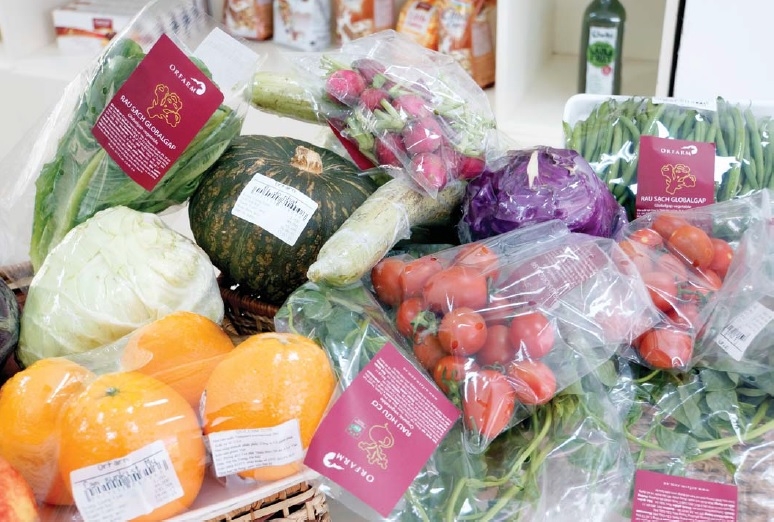Expanding agricultural brands
 |
| Vietnam is known globally for agricultural products, but can learn lessons from others in driving brand awareness |
On the agricultural map, Vietnam is always high on the list of countries producing and exporting rice, coffee, pepper, fruits, industrial crops, and aquatic products. With its rich potential, almost every locality has at least a handful of famous specialties, such as Hung Yen’s big longan, Thanh Ha litchi, Thai Nguyen tea, and Phu Quoc fish sauce.
However, despite the potential, the development of these products is limited. Many producers, businesses, organisations, and localities have not paid much attention to the protection of intellectual property rights for agricultural products and very few of them have gained international prestige. Most Vietnamese products are exported in raw form and product branding activities through geographical indications, showing where the goods are produced, are still amateur at best.
In 2016, more than 80 per cent of Vietnam’s agricultural products did not have trademarks, and 90 per cent of products were exported to the global market under foreign brands. There are 900 agricultural specialties in 700 locations nationwide, but only 48 products meet the national geographical indications, only 15 out of the 58 members of the Vietnam Vegetable and Fruit Association have registered trademarks in Vietnam, and 140 collective and certification marks have been registered for intellectual property rights protection.
This is especially true for coffee, which is one of Vietnam’s most famous agricultural products. According to the statistics of the Ministry of Agriculture and Rural Development, 95 per cent of Vietnamese coffee is exported in the form of raw materials, accounting for nearly 40 per cent of the global market, but the export value only accounts for 2 per cent of these products. Vietnam has only three major instant coffee brands and 20 roasted coffee brands exported worldwide. Meanwhile, Brazil has 20 brands of instant coffee and 3,000 brands of roasted coffee.
Some agricultural products and specialties are also floundering in the domestic market despite their high quality. For example, the famous Binh Thuan dragon fruit is sold widely on the streets for only $1 per several kilogrammes, and Vietnamese people even prefer imported Thai rice and jackfruit to local produce. Even more so, there are only two wine brands in Dalat which produce a limited number of bottles.
In fact, consumers are willing to spend more money buying a product of clear origin, quality, and prestigious brand. Studies in the European Union show that 43 per cent of European consumers are willing to pay an extra 10 per cent for products with geographical indication, while 8 per cent would pay an extra 20 per cent, and 3 per cent would even pay up to 30 per cent extra.
This sad situation requires Vietnam to craft a specific strategy for branding and market development in order to increase the brand value of Vietnamese agricultural products and specialties in domestic and international markets.
POSITIVE CHANGES
In order to reach their full potential and raise the market value of Vietnamese agricultural products, a number of enterprises and localities producing regional specialties have strengthened ties and promotion of products across Vietnam’s provinces with large consumption markets. The connections for the consumption of regional specialties brings obvious benefits, especially as Vietnam is entering the global market with the implementation of commitments under free trade agreements, such as the Comprehensive and Progressive Agreement for Trans-Pacific Partnership (CPTPP), and the ASEAN Economic Community (AEC).
Many localities also have policies in place to encourage enterprises to build brands and participate in the supply chain, ensuring quality and origin requirements. According to Le Hong Thang, director of the Hanoi Department of Industry and Trade, since 2016 Hanoi has directly introduced the specialities of 46 cities and provinces into the distribution system of foreign enterprises, such as Japan’s AEON Mall, South Korea’s Lotte Mart, Thailand’s Central Group, and France’s Rungis Wholesale Market. However, businesses still need to promote on-the-spot exports such as connecting specialties with tourism sites and strengthen the promotion of the specialities of these tourist sites to foreign visitors. These strategies have proved extremely successful for Japan and Thailand, offering a wealth of lessons for Vietnamese businesses to study.
In addition, fairs promoting agricultural products and handicrafts are also organised in localities and increasingly attract tourists, such as the Vietnam Regional Specialities Fair, Ben Tre Fruit Fair, Safe and Clean Agricultural Products Fair, as well as the International Fair of Agriculture and Food.
First held in Hanoi in 2014, the Vietnam Regional Specialities Fair was launched with the aim of bringing outstanding specialities and goods of localities across the country to Hanoi, fanning the demand among the capital’s residents. After five years of organisation, the fair has become a platform to promote the outstanding products of each locality among consumers and connect production enterprises with domestic distribution and supply units.
This year’s fair also included the “One Commune One Product – OCOP” exhibition with nearly 300 pavilions of 200 Vietnamese enterprises and businesses from six countries in the world. Beside the specialties of the region, the fair also showcased more than 20 craft villages from Hanoi via nearly 100 pavilions, creating a vivid picture of the potential of the craft villages.
Nguyen Thi Mai Anh, deputy director of the Hanoi Promotion Agency (HPA) said many organisations registered to participate, but due to limited space, organisers had to promise to keep reservation for the next season.
Participating for the first time in Vietnam Regional Specialities Fair, Hoang Duong, production manager of L’orchata Vietnam Nut Milk JSC, said that the company’s main product is cashew milk made from Binh Phuoc province’s famous cashew produce. In the future, the company will also set up new product lines from lotus seed and green beans made from materials originating from Vietnam.
Duong said, “We were very proud when the locally-sourced products of L’orchata appeared in the L’Place and Tomita supermarkets where up to 80 per cent of goods are imported. We have received good feedback from customers, and in the coming time, we will appear at Vinmart and Circle K and we are planning to penetrate Southeast Asia and South Korea. I think this will also be a way for us to promote and contribute to improving the value of Vietnamese agricultural products.”
| Daniel Dobrev, Head of Commercial, Bulgarian Embassy in Vietnam
First of all, Bulgaria is well-known for its rose products, which include perfumes, face creams, body creams, body scrubs, and tonic water, among others with the main products being cosmetics based on rose and lavender. We have different kinds of cosmetics with good quality and reasonable prices. We want to emphasise the quality of our ingredients to our Vietnamese partners. We also have Bulgarian cheese produced in Moc Chau. The milk is sourced from Moc Chau, but the food itself is Bulgarian, and we are very proud of our success among Vietnamese customers. We also have plans to introduce Bulgarian roses. We have already visited Hanoi, Sapa, Moc Chau, and Dalat to showcase our spices and oils. We are ready to co-operate with the likes of VinMart, Lotte Mart, and BigC. Regarding our standards of selecting partners, once they can prove themselves to be trustworthy, we will keep co-operating with them. ManshaH Muhammad , Director, Qaisar Co. Ltd.
We are looking to invest in healthy and organic products in Vietnam. Our company’s organic products satisfy FDA and ISO standards. We want more people to life a healthy life, I hope that every city in Vietnam has our branches. We are confident that our quality can meet nearly every standard. We have been selling products in the US and Europe, and we also have branches in Taiwan. I love Vietnam and have always wanted to invest in the country. The only problem is that the government’s policies change regularly. This makes foreign investors worried because they are uncertain of their long-term business prospects. This also causes concerns to us. |
What the stars mean:
★ Poor ★ ★ Promising ★★★ Good ★★★★ Very good ★★★★★ Exceptional
Related Contents
Latest News
More News
- Businesses ramp up production as year-end orders surge (December 30, 2025 | 10:05)
- Vietjet chairwoman awarded Labour Hero title (December 29, 2025 | 13:06)
- How to unlock ESG value through green innovation (December 29, 2025 | 10:03)
- AI reshapes media and advertising industry (December 29, 2025 | 08:33)
- FPT and GELEX sign deal to develop blockchain tech for global markets (December 29, 2025 | 08:29)
- Vietnam’s GDP forecast to grow by 9 per cent in 2026 (December 29, 2025 | 08:29)
- Women entrepreneurs are key to Vietnam’s economic growth (December 29, 2025 | 08:00)
- Vietnam's top 500 value-creating enterprises announced (December 27, 2025 | 08:00)
- The PAN Group shaping a better future with ESG strategy (December 26, 2025 | 09:00)
- Masan Consumer officially lists on HSX, marking the next phase of value creation (December 25, 2025 | 13:20)



 Tag:
Tag:




















 Mobile Version
Mobile Version